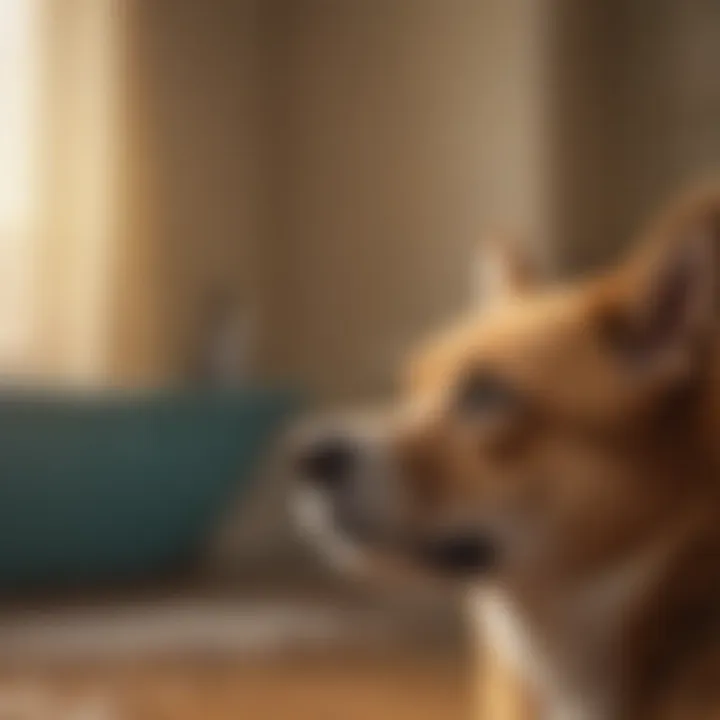Neutralizing Pet Urine Odor: Proven Solutions for Pet Owners


Intro
Dealing with pet urine odor is a common challenge for many pet owners. The distinct and often persistent smell can be frustrating and embarrassing, especially when hosting guests. Understanding the reasons behind these odors is crucial for determining effective solutions. In this article, we explore various methods to neutralize pet urine smells, offering practical tips and expert advice.
Pet Care and Grooming
Importance of Regular Care
Maintaining a clean living environment begins with proper pet care. Regular grooming is essential, not just for aesthetics, but also for health. Accumulated dirt and waste can contribute to odors. Frequent baths, especially for long-haired breeds, significantly reduce the chances of lingering smells.
Grooming Techniques by Pet Type
Different pets have unique grooming needs. For dogs, regular brushing and bathing are important. Cats, meanwhile, groom themselves, but occasional brushing helps minimize hairballs and odors. Small animals like rabbits also benefit from regular cleaning of their cages to avoid ammonia build-up from urine.
Tools and Products Recommendations
Investing in the right tools can make a significant impact on pet care. Some must-have items include:
- High-quality pet shampoo to neutralize odors
- Durable brushes tailored for each pet type
- Effective cleaning solutions specifically designed for pet stains
These tools help in keeping pets clean and minimizing urine odors in the home.
Seasonal Care Tips
Seasonal changes can affect pet care routines. In winter, it's important to wipe pets' paws after outdoor walks to prevent tracking in dirt and snow. Summer may require more frequent baths due to increased outdoor activity, which can heighten odors from sweat and urine.
Health and Nutrition
Understanding Pet Nutrition
A balanced diet plays a vital role in a pet’s overall health and odor control. By ensuring that pets receive appropriate nutrition, owners can minimize health issues that might lead to odor problems.
Common Health Issues by Species
Certain health issues can contribute to unpleasant smells. For instance, urinary tract infections in dogs can cause stronger urine odors. Regular vet check-ups help in early detection and treatment of such issues.
Preventive Care and Regular Check-Ups
Preventive care is key to maintaining pet health. Regular vet visits allow for monitoring of diet and health. Keeping vaccinations up-to-date can also prevent illnesses that result in odor.
Food and Dietary Advice
Choosing high-quality pet food can have a positive impact on odor control. Foods with high moisture content can help dilute urine, leading to less potent smells. Additionally, consulting with a vet about dietary changes can help in addressing specific odor concerns.
Behavioral Training
Basics of Positive Reinforcement
Training pets effectively can also mitigate odors. Using positive reinforcement techniques promotes good behavior which can reduce bathroom accidents indoors.
Training Techniques Users Can Apply
Consistency is vital in training. Taking pets out regularly and rewarding them for eliminating outside builds a positive habit. For example, using specific phrases and treats can reinforce desired behaviors.
Managing Behavioral Issues
Addressing behavioral issues early is crucial. If a pet is urinating in the house, identifying triggers and consulting a professional trainer can provide valuable solutions.
Importance of Socialization
Socializing pets is another preventive strategy. Well-socialized pets tend to exhibit better behavior overall, reducing the likelihood of indoor accidents caused by stress or anxiety.
Engaging Activities and Enrichment
Fun Games to Play with Your Pet
Engaging pets in interactive games can reduce stress and behavioral issues. Simple games like fetch for dogs or puzzle toys for cats can be stimulating and provide an outlet for energy.
DIY Toys and Activities


Creating DIY toys can also be budget-friendly and effective. For instance, using cardboard boxes or old clothes can provide pets with hours of entertainment.
Importance of Mental Stimulation
Mental stimulation is as important as physical activity. Bored pets are more likely to develop behavioral issues. Keeping them occupied with toys or training can help mitigate this.
Outdoor Adventures and Exploration
Taking pets outdoors provides an opportunity for exercise and exploration. Regular outdoor time not only enriches their lives but can also help in reducing indoor odors with regular bathroom breaks in fresh air.
Resources and Community Engagement
Recommended Books and Websites
Several resources provide valuable insights into pet care and odor neutralization. Websites like Wikipedia and Britannica offer extensive articles on pet care topics.
Forums and Groups for Pet Owners
Engaging with communities on platforms like Reddit can also be beneficial. Here, owners can exchange tips and experiences related to odor management.
Finding Local Services and Classes
Many local veterinary clinics and pet stores offer classes on pet training and care. Utilizing these services can provide hands-on assistance in addressing odor issues.
Encouraging Community Sharing and Contributions
Fostering a community where pet owners can share experiences promotes learning. Social media platforms such as Facebook offer groups for pet owners to connect and share solutions.
By understanding and implementing the right strategies, pet owners can effectively neutralize urine odor and create a healthier environment for both pets and people.
Understanding Pet Urine Odor
Understanding pet urine odor is crucial for any responsible pet owner. This knowledge enables individuals to address the unpleasant scents effectively, ensuring a healthier living environment for both pets and humans. The ability to recognize how urine odors develop and persist can lead to more effective cleaning solutions.
The Role of Ammonia in Pet Urine
Ammonia is a significant component of pet urine. When urine breaks down, bacteria metabolize urea, producing ammonia. This compound is notorious for its sharp, pungent scent, often reported by pet owners. The presence of ammonia signals the breakdown of urine, indicating its age and the level of bacterial activity. Moreover, ammonia can contribute to respiratory irritation, posing risks to pet and human health when concentrated.
In addition to its health implications, ammonia can significantly hinder cleaning efforts. If not neutralized, it can become a persistent source of odor, especially in confined spaces. Understanding how ammonia behaves in pet urine allows for more targeted cleaning strategies.
Bacterial Growth and Odor Development
Bacterial growth is a primary factor in the development of pet urine odor. When a pet urinates indoors, moisture creates an optimal environment for bacteria. As these microorganisms proliferate, they break down the components of urine. This process results in the production of various gases, which contribute to the foul smell often associated with pet urine.
Once the conditions are right, the bacteria can multiply rapidly. This is why stains that are not cleaned properly can continue to cause odor for weeks or even months. Therefore, it is essential to clean urine stains promptly, effectively reducing bacterial populations. Using appropriate cleaning agents can help to inhibit bacterial growth, limiting the impact they have on indoor air quality and overall odor.
Understanding the role of ammonia and bacteria in pet urine is vital for any pet owner. Effective removal of odors is not just about cleaning; it’s about understanding the origin of the problem.
In summary, comprehending pet urine odor involves recognizing the significance of ammonia and the role of bacterial growth. This knowledge lays the groundwork for effective cleaning solutions and habits, ensuring that home environments remain pleasant and healthy.
Identifying the Source of the Odor
Identifying the source of pet urine odor is crucial for effective remediation. Pet owners often find themselves dealing with persistent smells that linger long after cleaning attempts. Understanding where the odor originates can greatly enhance the effectiveness of cleaning solutions and strategies. By pinpointing the source of the odor, pet owners can target their efforts more accurately, making the cleaning process more efficient. This section will cover two significant methods: spotting urine stains and utilizing black lights.
Spotting Urine Stains
Identifying urine stains can be challenging, especially on carpets and upholstery that absorb liquid. Regular inspections of high-traffic areas and pet hotspots in the home can aid in noticing any discoloration or unusual odors. Pet urine can affect the surface it contacts, often leaving behind a unique stain.
Some signs include:
- Discoloration: Look for yellowish patches on carpets, rugs, or floors.
- Texture Changes: A slight change in texture may indicate an area that has absorbed urine.
Acting promptly when urine incidents occur is beneficial. Clean immediately to prevent deep penetration into the fabrics or materials. It's advisable to use clean, absorbent cloths to blot the area. This method reduces the amount of moisture that seeps deeper into the surface.
Utilizing Black Lights
Using a black light can be an effective means of identifying hidden urine stains that are not visible under regular light. Black lights make urine residues fluoresce, making it easier to detect areas that need cleaning.
Steps to Follow:


- Purchase a Black Light: These lights are widely available in pet supply stores or online.
- Dim the Lights: Ensure the area is dark for better visibility of stains.
- Scan the Area: Move the black light slowly across the floor, furniture, and carpets.
When using a black light, expect to see a bright glow where urine is present. This allows for targeted cleaning efforts.
Tip: It's helpful to keep track of areas that exhibit stains for ongoing maintenance.
Understanding the source of urine odor is essential for addressing the issue effectively. By employing both spotting urine stains and utilizing black lights, pet owners can significantly improve their cleaning strategies, ensuring a fresher and more inviting indoor environment.
Cleaning Techniques for Pet Urine
Cleaning techniques for pet urine are fundamental in addressing the odor that can persist in homes due to pet accidents. Understanding and implementing effective cleaning methods can significantly improve indoor air quality and enhance the living environment for both pets and humans. The right approach combines the use of absorbents, homemade solutions, and commercial products, each with specific benefits and considerations. Choosing the appropriate cleaning method can mitigate the lasting impact of pet urine, ensuring that homes remain fresh and inviting.
Absorbents and Their Effectiveness
Absorbents play a crucial role in early intervention when dealing with pet urine accidents. Products like paper towels, old cloths, and specialized absorbent pads can quickly soak up liquid and minimize spread.
- Immediate Action: It is vital to act fast when noticing an accident to absorb as much liquid as possible. The longer urine sits, the more likely it is for the odor to set in.
- Types of Absorbents: Common absorbents include:
- Baking soda: It not only absorbs moisture but also aids in neutralizing odors.
- Cat litter: Designed to absorb moisture from waste, it can be repurposed for cleaning accidents.
- Commercial absorbent pads: Created specifically for pet owners, these pads can handle large amounts of liquid effectively.
Ensure you blot stains rather than rubbing them. Rubbing can push the urine deeper into fabrics and surfaces.
Water and Vinegar Solutions
A simple mixture of water and vinegar can serve as an effective solution against pet urine odor. Vinegar has strong antibacterial properties that can help eliminate both the stain and the smell.
- How to Prepare: Combine equal parts water and vinegar in a spray bottle. This solution works well on many surfaces including carpets, furniture, and other fabric areas.
- Application: Spray the solution on the affected area and let it sit for several minutes before blotting with a clean cloth.
- Why It Works: The acidity of vinegar neutralizes the alkaline salts in pet urine, while the water helps in lifting the stain.
This method is not only effective but also easy to create using household items, making it accessible for most pet owners.
Commercial Cleaning Products
For persistent urine odors and stains, commercial cleaning products may be necessary. There are numerous enzymatic cleaners available that work to break down urine components.
- Enzymatic Cleaners: These are specially formulated to target the proteins and bacteria in pet urine. Brands such as Nature's Miracle or Rocco & Roxie are popular choices.
- Selecting Quality Products: Look for products that specify their efficiency against urine stains and odors. Reading reviews and ratings can help in making informed decisions.
- Application Guidelines: Always follow the manufacturer's instructions for the best results, as incorrect use can lead to unsatisfactory cleaning outcomes.
In summary, effective cleaning techniques for pet urine include a mix of absorbent methods, household solutions like water and vinegar, and specialized commercial products. Each method has its place in maintaining a clean environment, essential for the comfort and health of both pets and their owners.
DIY Solutions for Odor Neutralization
DIY solutions for neutralizing pet urine odor are essential for maintaining a clean and healthy environment. Unlike commercial products that may include harsh chemicals, DIY methods utilize common household items that are both effective and safe. People who own pets regularly encounter odor issues, and relying on DIY strategies can offer immediate relief. Moreover, these solutions are often cost-effective, allowing pet owners to address odors without significant financial impact. By understanding these methods, you empower yourself to control the situation without seeking constant professional help.
Baking Soda Applications
Baking soda is widely regarded as a versatile and effective solution for neutralizing odors. Its chemical structure allows it to absorb moisture and combat unpleasant smells. When it comes to pet urine, the alkaline nature of baking soda neutralizes the acidic compounds found in urine, diminishing the odor significantly.
- Application Process: To use baking soda for odor control, first clean the affected area with water to remove urine residue. Once the area is dry, sprinkle a generous amount of baking soda over the stain. Let it sit for several hours, or overnight if possible. This allows the baking soda to absorb odors effectively.
- Vacuuming: After allowing it to sit, vacuum the area thoroughly. The baking soda should remove the odor, and the once-affected area will smell fresh again.
- Concentration Areas: Baking soda can be used not just on carpets but also on mattresses, upholstery, and in pet bedding. In each case, the procedure remains the same—sprinkle, wait, and vacuum.
An important aspect to remember is that while baking soda is effective, it may not completely eliminate older, set-in stains or odors caused by prolonged exposure. In such cases, a combination of methods might be necessary for full effectiveness.
Essential Oils and Their Uses
Essential oils provide a natural alternative for combating pet odor. They have antibacterial and antifungal properties, which can aid in breaking down odor-causing bacteria. However, choosing the right oils is crucial, as some essential oils can be harmful to pets.
- Safe Options: Recommended oils include lavender, chamomile, and cedarwood. These oils are not only effective in masking odors but can also help relax pets due to their calming properties. Always dilute essential oils in a carrier oil or water before applying to surfaces. This reduces the potency and ensures safety.
- Application Method: To use essential oils, mix a few drops with water in a spray bottle. Lightly mist the area after cleaning it properly. This application not only provides fragrance but also contributes to odor neutralization.
- Considerations: It is vital to monitor your pet's reaction. If you notice any signs of distress, discontinue use immediately. Additionally, avoid using essential oils on fabrics that are frequently in direct contact with pets.
In summary, DIY solutions for pet urine odor offer effective ways to manage what can be a challenging issue for pet owners. Using baking soda and essential oils allows you to control the environment easily and economically while ensuring safety for both pets and humans.
Preventing Recurrence of Pet Urine Odor
Preventing recurrence of pet urine odor is crucial for maintaining a healthy living environment. If not properly addressed, this issue can lead to an accumulation of odor and even affect indoor air quality. Pet urine contains compounds like ammonia, which can linger and result in persistent foul smells. Moreover, regular cleaning and preventive measures save time and resources in the long run. Establishing a consistent routine and understanding pet behavior is important for pet owners.
Establishing Routine Cleaning
Routine cleaning is an essential component in managing pet urine odor. Regularly scheduled cleaning minimizes the risk of stains setting in and reduces the possibility of odor becoming entrenched in carpets, rugs, or furniture.
- Frequency of Cleaning: Implement a regular cleaning schedule, ideally on a weekly basis, to address potential urine stains before they become a problem.
- Spot Cleaning: For areas where accidents happen frequently, use absorbent materials to immediately soak up any urine. The longer the urine sits, the more challenging it is to clean.
- Use of Enzymatic Cleaners: Invest in enzymatic cleaners that break down the proteins in urine, effectively neutralizing odor. These products are preferable over traditional cleaners, which might mask the smell without fully eliminating it.
- Attention to Detail: Focus on high-traffic areas as well as corners and places where pets like to linger. Pay special attention to upholstery, as it can trap odors easily.
Adhering to a routine can significantly mitigate the odor threat, fostering a more pleasant living space.


Behavioral Training for Pets
Behavioral training plays a pivotal role in preventing urine odor issues. By understanding and addressing the root causes of behavior that lead to urination indoors, pet owners can curtail future occurrences.
- Potty Training: Start with proper potty training from an early age. Consistent reinforcement of taking pets outside can help instill good habits.
- Recognizing Signals: Learn to identify signals that pets may need to go out. Scratching at the door or whining can indicate their need to relieve themselves.
- Positive Reinforcement: Utilize positive reinforcement techniques. Reward pets with treats or praise when they urinate outside. This method encourages good behavior in the long run.
- Limit Access: Limit access to certain areas of the house, especially during the early stages of training. This can prevent accidents from occurring in places you may have difficulty cleaning.
Here, proactive training can lead to a noticeable reduction in accidents. Behavioral understanding combined with routine cleaning creates an effective strategy in neutralizing pet urine odor before it becomes a recurring challenge.
Important Note: By integrating both cleaning methods and behavioral training, pet owners can create a harmonious living environment that supports the well-being of both pets and humans.
Impact of Urine Odor on Indoor Air Quality
Pet urine odor is not just an unpleasant smell; it can significantly impact indoor air quality. When pets urinate indoors, ammonia and bacteria are released into the air, creating an environment that can pose health risks to both humans and animals. Understanding how these elements affect air quality is crucial for anyone living with pets.
Health Implications for Humans and Pets
Pet urine, primarily composed of ammonia, can be harmful. Ammonia can trigger respiratory issues, especially in individuals with asthma or allergies. Similarly, pets exposed to strong urine odors might experience irritation in their nasal passages and respiratory systems. Here are some potential health implications:
- Respiratory distress in sensitive individuals.
- Increased allergy symptoms due to bacterial growth.
- Possible skin irritations if contact occurs.
"Proper odor management is essential not only for comfort but also for health and safety in pet-friendly homes."
By neutralizing pet urine odor, owners can protect their families and improve overall well-being.
Ventilation and Its Significance
Proper ventilation is key to maintaining good indoor air quality, especially in homes where pets are present. Stagnant air can trap odors and allergens, exacerbating the issue. Regularly introducing fresh air helps to dissipate pet urine smells and ensure a healthier living environment. Key points include:
- Open windows to allow airflow.
- Use air purifiers equipped with HEPA filters to remove irritants.
- Ensure that heating and cooling systems are clean and well-maintained.
When to Seek Professional Help
Understanding when to bring in a professional cleaning service can be crucial for pet owners dealing with persistent urine odor. The severity of the problem may sometimes exceed simple home remedies or available cleaning products. Ignoring potent odors can lead to further damage in your home, including staining on carpets or floors and even potential health risks due to lingering bacteria.
Seeking professional help offers several benefits. First, experts may have access to specialized cleaning equipment designed to eliminate odors at their source. They also bring experience with various cleaning agents that can be more effective than common household solutions. Moreover, a professional can assess the affected area more thoroughly, providing solutions tailored to the unique challenges presented by your home environment.
When considering options, think about the extent of the odor. If the smell is overpowering or you notice it affecting multiple areas in the home, then it is time to consult professionals. It is also important to consider whether the odor is recurring despite your best efforts. Professionals can effectively target hidden stains or odors you might not be able to reach.
Assessing the Severity of the Problem
Assessing the severity of the problem is necessary before contacting a cleaning service. Start by conducting a thorough inspection of your home. Pay close attention to areas where pets frequently urinate. It is also useful to consider the duration since the stain occurred. Fresh stains are often easier to address than older ones, which may have set in deeper.
Here are some aspects to consider when evaluating severity:
- Odor Strength: Notice how strong the scent is. A faint familiarity often indicates a small issue, while a strong, lingering odor suggests a larger problem.
- Stain Visibility: Check for visible signs of staining. Darker areas on carpets or floors may indicate a need for professional intervention.
- Area Affected: Identify how widespread the issue is. If urine odor spans multiple rooms, that indicates a more significant concern.
- Underlying Issues: Determine whether there are additional factors such as moisture problems, which can exacerbate odor issues.
If significant issues are found, reaching out to a professional cleaning service may be the best next step.
Selecting a Cleaning Service
Choosing the right cleaning service for pet urine odor removal requires careful consideration. All services are not created equal, and your specific needs should guide your decision. Start by researching local companies that specialize in pet odor removal. Read reviews and look for feedback from previous customers, particularly those who had similar issues.
When selecting a service, keep the following factors in mind:
- Experience and Expertise: Consider how long the company has been in business and their expertise in handling pet odor issues. Experience can often translate into better results.
- Techniques and Products Used: Ask about the cleaning methods they employ. Ensure they use safe, effective products that won't harm your pets.
- Guarantees and Policies: Inquire whether they offer satisfaction guarantees. This can help protect your investment if the result isn't what you expected.
- Cost Estimates: Obtain written estimates from multiple services. This comparison can ensure you receive fair pricing while still not compromising on quality.
- Communication: A good service will communicate clearly. They should provide a detailed explanation of the process and answer any questions you might have about the service.
In summary, carefully researching and assessing the severity of your urine odor problem will guide you toward making a well-informed decision about seeking professional help. Doing so will protect your home and ensure a more livable environment for both you and your pets.
Culmination
In the quest for a clean and fresh home, understanding how to effectively neutralize pet urine odor is paramount for any pet owner. Residual odors can have far-reaching effects, impacting both the living environment and the well-being of both animals and humans. Acknowledging the underlying causes, such as ammonia and bacterial growth, is essential. It allows pet owners to focus on the correct cleaning methods and preventative strategies.
The key elements discussed throughout this article converge to form a comprehensive action plan. By identifying the odor source and utilizing appropriate cleaning techniques, effective solutions become attainable. Additionally, regular maintenance and behavioral training can significantly lower future occurrences of odor.
In short, tackling pet urine odor should not be approached lightly. The multifaceted strategies laid out here are designed to empower pet owners. The result is a cleaner, healthier space that benefits both pets and humans.
Summary of Key Points
- Understanding pet urine odor involves recognizing components like ammonia and how bacteria contribute to unpleasant scents.
- Identifying the source of the odor is crucial. Methods include spotting stains and using black lights for better accuracy.
- Cleaning techniques range from absorbents, like baking soda, to water and vinegar solutions, as well as more specific commercial products.
- DIY solutions provide cost-effective alternatives while offering satisfactory results in tackling urine odor.
- Preventive measures, including regular cleaning and pet behavioral training, help avoid future issues with odor.
- Assessing whether to seek professional help based on the severity of the problem is a valuable step in maintaining a fresh environment.
Final Recommendations for Pet Owners
To maintain an odor-free home, pet owners should consider the following recommendations:
- Implement a Routine: Establish a regime for regular cleaning to reduce odor build-up. Schedule times for specific cleaning tasks related to pets.
- Invest in Quality Products: Utilize reliable cleaning agents designed specifically for pet odors. Brands like Nature's Miracle or Simple Solution can be very effective.
- Behavioral Training: Train pets to relieve themselves outside as much as possible. Reinforce positive behavior with rewards.
- Responsive Cleaning: Address accidents immediately. The faster a stain and odor are treated, the easier they are to remove.
- Stay Informed: Regularly research and update cleaning methods and products to stay ahead in maintaining a fresh living space. Engage in communities or platforms like Reddit to share insights and learn from other pet owners.
By incorporating these strategies and remaining proactive, pet owners can significantly enhance their living environment, ensuring comfort for both themselves and their beloved pets.















